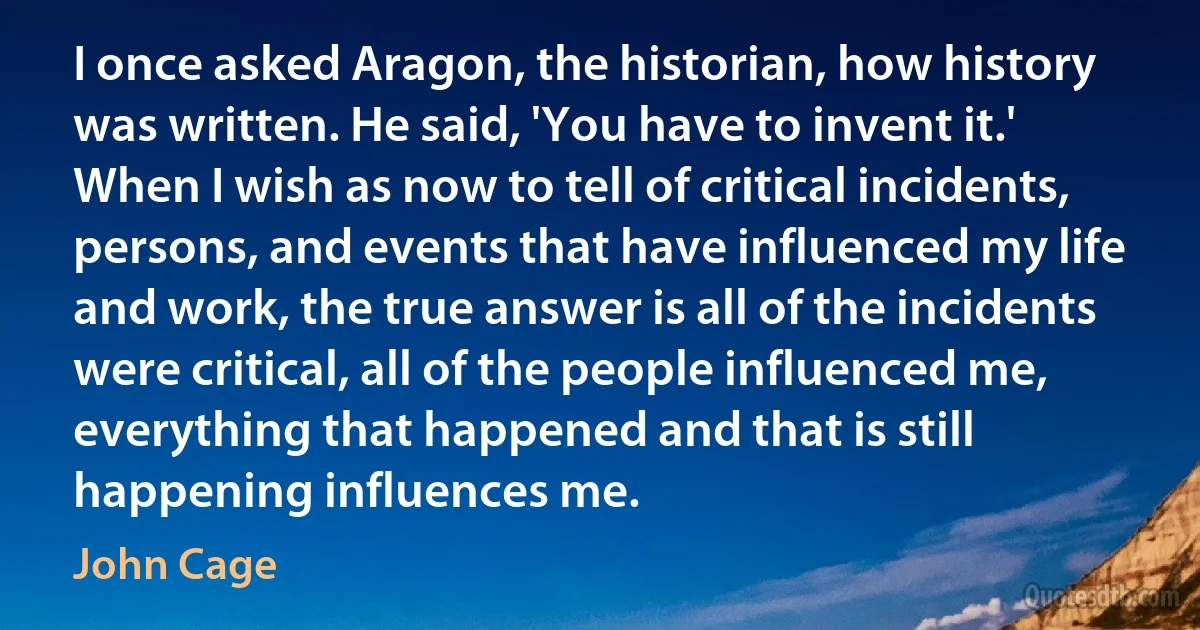John Cage quotes - page 2
Critics frequently cry 'Dada' after attending one of my concerts or hearing one of my lectures. Others bemoan my interest in w:Zen. One of the liveliest lectures I ever heard was given by Nancy Wilson Ross at the Cornish School in Seattle. It was called Zen Buddhism and Dada. It is possible to make a connection between the two, but neither Dada nor Zen is a fixed tangible. They change; and in quite different ways in different places and times, they invigorate action. What was Dada in the 1920's is now, with the exception of the work of Marcel Duchamp, just art. What I do, I do not wish blamed on Zen, though without my engagement with Zen... I doubt whether I would have done what I have done... I often point out that Dada nowadays has in it a space, an emptiness, that it formerly lacked. What nowadays, America mid-twentieth century, is Zen?

John Cage
David Tudor and I went to Hilversum in Holland to make a recording for the Dutch radio. We arrived at the studio early and there was some delay. To pass the time, we chatted with the engineer who was to work with us. He asked me what kind of music he was about to record. Since he was a Dutchman I said, 'It may remind you of the work of Mondrian.' When the session was finished and the three of us were leaving the studio, I asked the engineer what he thought of the music we had played. He said, 'It reminded me of the work of Mondrian.

John Cage
I believe that the use of noise to make music will continue and increase until we reach a music produced through the use of electrical instruments which will make available for musical purposes any and all sounds that can be heard. Photoelectric, film and mechanical mediums for the synthetic production of music will be explored.

John Cage
So it was that I gave about 1949 my 'Lecture on Nothing' at the Artists' Club on Eighth Street in New York City (started by Robert Motherwell), which predated the popular one associated with Philip Pavia, Bill de Kooning, et al. ). This 'Lecture on Nothing' was written in the same rhythmic structure I employed at the time in my musical compositions (Sonatas and Interludes, Three Dances, etc.). One of the structural divisions was the repetition, some fourteen times, of a single page in which occurred the refrain, 'If anyone is sleepy let him go to sleep.' Jeanne Reynal, I remember, stood up part way through, screamed, and then said, while I continued speaking, 'John, I dearly love you, but I can't bear another minute.' She then walked out. Later, during the question period, I gave one of six previously prepared answers regardless of the question asked. This was a reflection of my engagement in Zen.

John Cage
At Black Mountain College in 1952, I organized an event that involved the paintings of Bob Rauschenberg, the dancing of Merce Cunningham, films, slides, phonograph records, radios, the poetries of w:Charles Olson and M. C. Richards recited from the tops of ladders, and the pianism of David Tudor, together with my 'Juilliard lecture', which ends: 'A piece of string, a sunset, each acts.' The audience was seated in the center of all this activity. Later that summer, vacationing in New England, I visited America's first synagogue, to discover that the congregation was there seated precisely the way I had arranged the audience at Black Mountain.

John Cage
I certainly had no feeling for harmony, and Schoenberg thought that that would make it impossible for me to write music. He said, 'You'll come to a wall you won't be able to get through.' I said, 'Well then, I'll beat my head against that wall.' I quite literally began hitting things, and developed a music of percussion that involved noises.

John Cage
They say, 'you mean it's just sounds?' thinking that for something to just be a sound is to be useless, whereas I love sounds just as they are, and I have no need for them to be anything more than what they are. I don't want them to be psychological. I don't want a sound to pretend that it's a bucket or that it's president or that it's in love with another sound. I just want it to be a sound.

John Cage
...WHEREAS, IN THE PAST, THE POINT OF DISAGREEMENT HAS BEEN BETWEEN DISSONANCE AND CONSONANCE, IT WILL BE, IN THE IMMEDIATE FUTURE, BETWEEN NOISE AND SO-CALLED MUSICAL SOUNDS.
THE PRESENT METHODS OF WRITING MUSIC, PRINCIPALLY THOSE WHICH EMPLOY HARMONY AND ITS REFERENCE TO PARTICULAR STEPS IN THE FIELD OF SOUND, WILL BE INADEQUATE FOR THE COMPOSER, WHO WILL BE FACED WITH THE ENTIRE FIELD OF SOUND.

John Cage
The composer (organizer of sound) will be faced not only with the entire field of sound but also with the entire field of time. The 'frame' or fraction of a second, following established film technique, will probably be the basic unit in the measurement of time. No rhythm will be beyond the composer's reach.
NEW METHODS WILL BE DISCOVERED, BEARING A DEFINITE RELATION TO SCHOENBERG'S TWELVE-TONE SYSTEM.

John Cage



